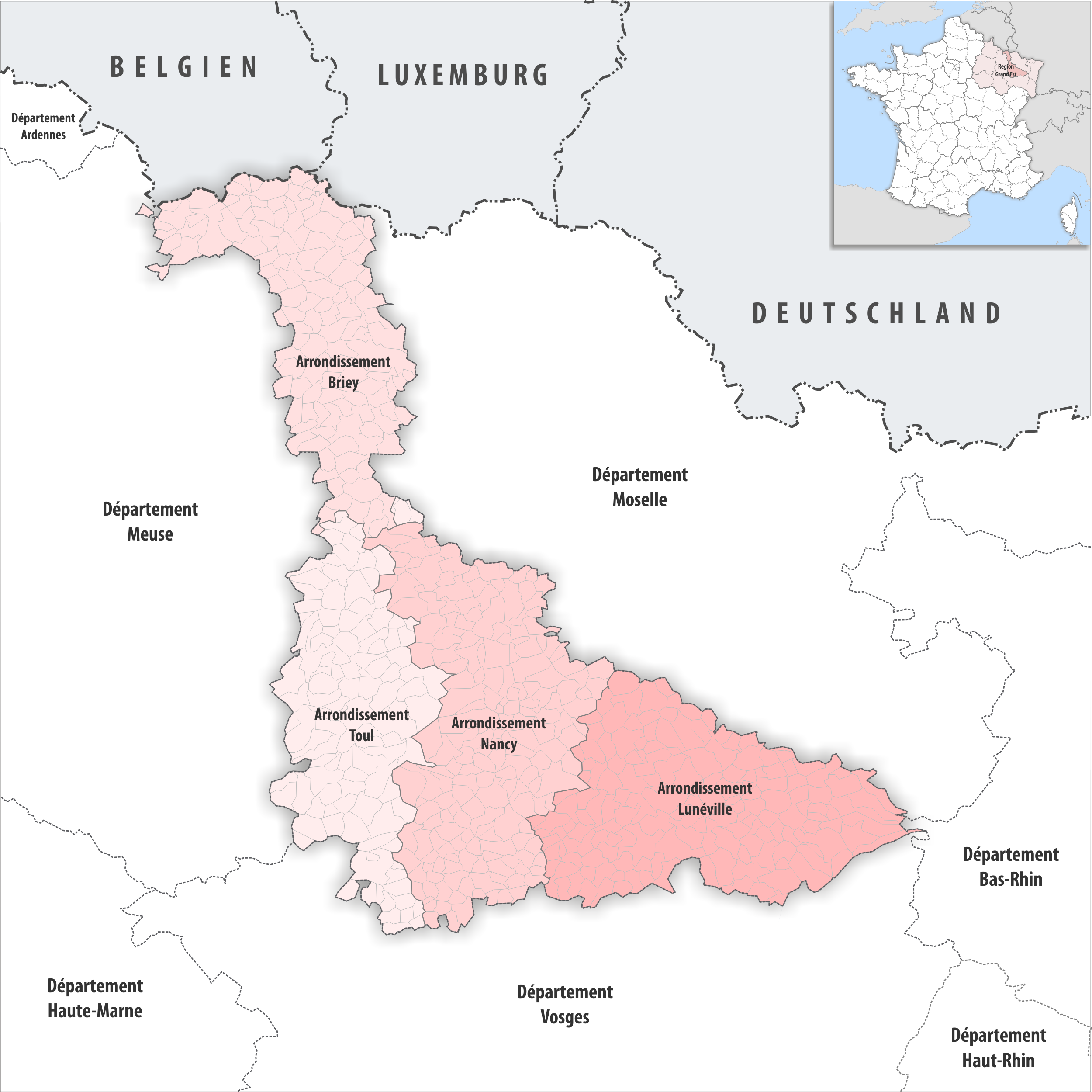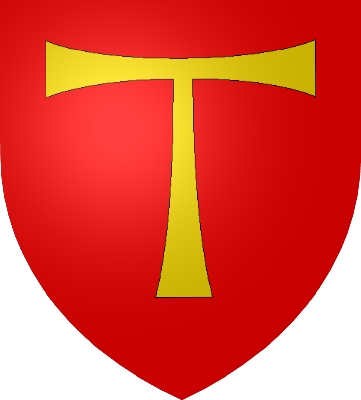|
Arrondissements Of The Meurthe-et-Moselle Department
The 4 arrondissements of the Meurthe-et-Moselle department are: # Arrondissement of Briey (subprefecture: Val de Briey), with 128 communes. The population of the arrondissement was 166,309 in 2016. # Arrondissement of Lunéville (subprefecture: Lunéville), with 164 communes. The population of the arrondissement was 78,662 in 2016. # Arrondissement of Nancy (prefecture of the Meurthe-et-Moselle department: Nancy), with 188 communes. The population of the arrondissement was 419,699 in 2016. # Arrondissement of Toul (subprefecture: Toul), with 111 communes. The population of the arrondissement was 69,151 in 2016. History In 1800 the arrondissements of Nancy, Château-Salins, Lunéville, Sarrebourg and Toul were established as subdivisions of the department Meurthe, and Briey as part of the department Moselle. In 1871 the parts of the departments Meurthe and Moselle that had not been ceded to Germany were combined in the new department Meurthe-et-Moselle, with the arrondi ... [...More Info...] [...Related Items...] OR: [Wikipedia] [Google] [Baidu] |
Département Meurthe-et-Moselle Arrondissement 2019
In the administrative divisions of France, the department (french: département, ) is one of the three levels of government under the national level ("territorial collectivity, territorial collectivities"), between the regions of France, administrative regions and the communes of France, communes. Ninety-six departments are in metropolitan France, and five are overseas department and region, overseas departments, which are also classified as overseas regions. Departments are further subdivided into 332 arrondissements of France, arrondissements, and these are divided into cantons of France, cantons. The last two levels of government have no autonomy; they are the basis of local organisation of police, fire departments and, sometimes, administration of elections. Each department is administered by an elected body called a departmental council (France), departmental council ( [sing.], [plur.]). From 1800 to April 2015, these were called general councils ( [sing.] [plur.]). Each ... [...More Info...] [...Related Items...] OR: [Wikipedia] [Google] [Baidu] |
Prefectures In France
In France, a prefecture (french: préfecture) may be: * the ''chef-lieu de département'', the commune in which the administration of a department is located; * the ''chef-lieu de région'', the commune in which the administration of a region is located; * the jurisdiction of a prefecture; * the official residence or headquarters of a prefect. Although the administration of departments and regions is distinct, a regional prefect is '' ex officio'' prefect of the department in which the regional prefecture is located. The officeholder has authority upon the other prefects in the region on a range of matters. Role of the prefecture There are 101 prefectures in France, one for each department. The official in charge is the prefect (french: préfet). The prefecture is an administration that belongs to the Ministry of the Interior; it is therefore in charge of the delivery of identity cards, driving licenses, passports, residency and work permits for foreigners, vehicle registration, ... [...More Info...] [...Related Items...] OR: [Wikipedia] [Google] [Baidu] |
Treaty Of Frankfurt (1871)
The Treaty of Frankfurt (french: Traité de Francfort; german: Friede von Frankfurt) was a peace treaty signed in Frankfurt on 10 May 1871, at the end of the Franco-Prussian War. Summary The treaty did the following: * Established the frontier between the French Third Republic and the German Empire, which involved the ceding of 1,694 French villages and cities to Germany in: ** Alsace: the French departments of Bas-Rhin and Haut-Rhin, except for the city of Belfort and its territory; ** Lorraine: most of the French department of Moselle, one-third of the department of Meurthe, including the cities of Château-Salins and Sarrebourg, and the cantons Saales and Schirmeck in the department of Vosges. * Gave residents of the Alsace-Lorraine region until 1 October 1872 to decide between keeping their French nationality and emigrating, or remaining in the region and becoming German citizens. * Set a framework for the withdrawal of German troops from certain areas. * Regulated t ... [...More Info...] [...Related Items...] OR: [Wikipedia] [Google] [Baidu] |
Moselle (department)
Moselle () is the most populous department in Lorraine, in the east of France, and is named after the river Moselle, a tributary of the Rhine, which flows through the western part of the department. It had a population of 1,046,543 in 2019.Populations légales 2019: 57 Moselle INSEE Inhabitants of the department are known as ''Mosellans''. History 
 On March 4, 1790, Moselle became one of th ...
On March 4, 1790, Moselle became one of th ...
[...More Info...] [...Related Items...] OR: [Wikipedia] [Google] [Baidu] |
Meurthe (department)
Meurthe () is a former department of France created in 1790. Its prefecture (capital) was Nancy. It ceased to exist following the annexation of Alsace-Lorraine by Germany in 1871. General characteristics The department of Meurthe was created on 4 March 1790, during the French Revolution, out of a part of the former province of Lorraine. It took its name from the river Meurthe flowing through it. As of 1866, Meurthe had 714 communes. Its area was 6,070 km2 (2,344 sq. miles). It was divided into 5 arrondissements: Nancy, Château-Salins, Lunéville, Sarrebourg and Toul. History After the French defeat in the Franco-Prussian War of 1870-1871, the northeastern part of the Meurthe department was annexed to the German Empire by the Treaty of Frankfurt. On 18 May 1871 about one-third of the Meurthe, corresponding approximately to the arrondissements of Château-Salins and Sarrebourg in the northeast of the department, were detached from Meurthe and annexed to the German Departmen ... [...More Info...] [...Related Items...] OR: [Wikipedia] [Google] [Baidu] |
Arrondissement Of Sarrebourg
The arrondissement of Sarrebourg is a former arrondissement of France in the Moselle department in the Lorraine region. In January 2016 it was merged into the new arrondissement of Sarrebourg-Château-Salins. It had 102 communes, and its population was 64,374 (2012).Populations légales 2012: 57 Moselle INSEE Composition The communes of the arrondissement of Sarrebourg, and their INSEE codes, were:History The arrondissement of Sarrebourg was created as par ...[...More Info...] [...Related Items...] OR: [Wikipedia] [Google] [Baidu] |
Arrondissement Of Château-Salins
The arrondissement of Château-Salins is a former arrondissement of France in the Moselle department in the Lorraine region. In January 2016 it was merged into the new arrondissement of Sarrebourg-Château-Salins. It had 128 communes, and its population was 29,818 (2012).Populations légales 2012: 57 Moselle INSEE Composition The communes of the arrondissement of Château-Salins, and their INSEE codes, were:History The arrondissement of Château-Salins was ...[...More Info...] [...Related Items...] OR: [Wikipedia] [Google] [Baidu] |
Toul
Toul () is a commune in the Meurthe-et-Moselle department in north-eastern France. It is a sub-prefecture of the department. Geography Toul is between Commercy and Nancy, and the river Moselle and Canal de la Marne au Rhin. Climate Toul has a oceanic climate (Köppen climate classification ''Cfb''). The average annual temperature in Toul is . The average annual rainfall is with June as the wettest month. The temperatures are highest on average in July, at around , and lowest in January, at around . The highest temperature ever recorded in Toul was on 11 August 1998; the coldest temperature ever recorded was on 9 January 1985. History Toul was known to the Romans as , and was the capital of the Gaulish tribe of the Leuci. In 550, King Theudebald convoked a synod at Toul. In 612, King Theudebert II of Austrasia was defeated by King Theuderic II of Burgundy near Toul. By the Treaty of Meerssen of 870, Toul became part of East Francia, the later Holy Roman Empire. Du ... [...More Info...] [...Related Items...] OR: [Wikipedia] [Google] [Baidu] |
Arrondissement Of Toul
The arrondissement of Toul is an arrondissement of France in the Meurthe-et-Moselle department in the Grand Est region. It has 111 communes. Its population is 69,151 (2016), and its area is . Composition The communes of the arrondissement of Toul, and their INSEE codes, are: # Aboncourt (54003) # Aingeray (54007) # Allain (54008) # Allamps (54010) # Andilly (54016) # Ansauville (54019) # Arnaville (54022) # Avrainville (54034) # Bagneux (54041) # Barisey-au-Plain (54046) # Barisey-la-Côte (54047) # Battigny (54052) # Bayonville-sur-Mad (54055) # Beaumont (54057) # Bernécourt (54063) # Beuvezin (54068) # Bicqueley (54073) # Blénod-lès-Toul (54080) # Bois-de-Haye (54557) # Boucq (54086) # Bouillonville (54087) # Bouvron (54088) # Bruley (54102) # Bulligny (54105) # Charey (54119) # Charmes-la-Côte (54120) # Chaudeney-sur-Moselle (54122) # Choloy-Ménillot (54128) # Colombey-les-Belles (54135) # Courcelles (54140) # Crépey (54143) # Crézilles (54146 ... [...More Info...] [...Related Items...] OR: [Wikipedia] [Google] [Baidu] |
Nancy, France
Nancy ; Lorraine Franconian: ''Nanzisch'' is the Prefectures in France, prefecture of the northeastern Departments of France, French department of Meurthe-et-Moselle. It was the capital of the Duchy of Lorraine, which was Lorraine and Barrois, annexed by France under King Louis XV in 1766 and replaced by a Provinces of France, province, with Nancy maintained as capital. Following its rise to prominence in the Age of Enlightenment, it was nicknamed the "capital of Eastern France" in the late 19th century. The metropolitan area of Nancy had a population of 511,257 inhabitants at the 2018 census, making it the 16th-largest functional area (France), functional urban area in France and Lorraine's largest. The population of the city of Nancy proper is 104,885. The motto of the city is , —a reference to the thistle, which is a symbol of Lorraine. Place Stanislas, a large square built between 1752 and 1756 by architect Emmanuel Héré under the direction of Stanislaus I of Poland to lin ... [...More Info...] [...Related Items...] OR: [Wikipedia] [Google] [Baidu] |
Arrondissement Of Nancy
The arrondissement of Nancy is an arrondissement of France in the Meurthe-et-Moselle department in the Grand Est region. It has 188 communes. Its population is 419,699 (2016), and its area is . Composition The communes of the arrondissement of Nancy, and their INSEE codes, are: # Abaucourt (54001) # Affracourt (54005) # Agincourt (54006) # Amance (54012) # Armaucourt (54021) # Arraye-et-Han (54024) # Art-sur-Meurthe (54025) # Atton (54027) # Autreville-sur-Moselle (54031) # Autrey (54032) # Azelot (54037) # Bainville-aux-Miroirs (54042) # Bainville-sur-Madon (54043) # Belleau (54059) # Belleville (54060) # Benney (54062) # Bey-sur-Seille (54070) # Bezaumont (54072) # Blénod-lès-Pont-à-Mousson (54079) # Bouxières-aux-Chênes (54089) # Bouxières-aux-Dames (54090) # Bouxières-sous-Froidmont (54091) # Bouzanville (54092) # Bralleville (54094) # Bratte (54095) # Brin-sur-Seille (54100) # Buissoncourt (54104) # Burthecourt-aux-Chênes (54108) # Ceintrey (54109) # ... [...More Info...] [...Related Items...] OR: [Wikipedia] [Google] [Baidu] |
Arrondissements Of France
An arrondissement (, , ) is any of various administrative divisions of France, Belgium, Haiti, certain other Francophone countries, as well as the Netherlands. Europe France The 101 French departments are divided into 342 ''arrondissements'', which may be roughly translated into English as districts. The capital of an arrondissement is called a subprefecture. When an arrondissement contains the prefecture (capital) of the department, that prefecture is the capital of the arrondissement, acting both as a prefecture and as a subprefecture. Arrondissements are further divided into cantons and communes. Municipal arrondissement A municipal arrondissement (, pronounced ), is a subdivision of the commune, used in the three largest cities: Paris, Lyon, and Marseille. It functions as an even lower administrative division, with its own mayor. Although usually referred to simply as an "arrondissement," they should not be confused with departmental arrondissements, which are groupin ... [...More Info...] [...Related Items...] OR: [Wikipedia] [Google] [Baidu] |


